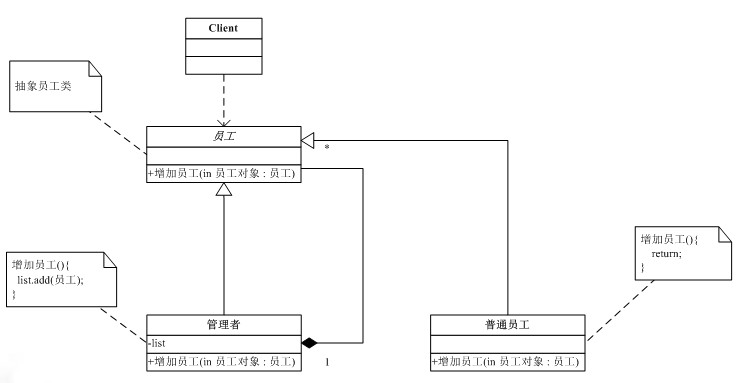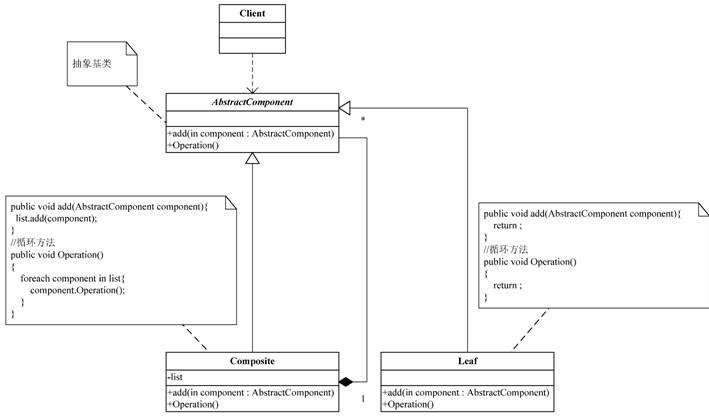Java组合模式表示公司组织结构 Java使用组合模式实现表示公司组织结构功能示例
chengqiuming 人气:1本文实例讲述了Java使用组合模式实现表示公司组织结构功能。分享给大家供大家参考,具体如下:
一、模式定义
组合模式:将对象组合成树形结构以表示“部分一整体”的层次结构,组合模式使得用户对单个对象和组合对象的使用具有一致性。
二、组合模式举例
1 模式分析
我们借用公司组织结构图来说明这一模式。
经过分析后,我们得出该模式静态类图如下:

2 代码示例
2.1 建立员工抽象类
package com.demo.composite;
/**
* 职工类接口
*
* @author
*
*/
public abstract class Staff {
// 员工号
protected String no;
// 职工名字
protected String name;
// 职位
protected String position;
// 薪资
protected float salary;
// 私有属性 长度字符串
private int length;
// 构造方法
public Staff(String no, String name, String position, float salary) {
this.no = no;
this.name = name;
this.position = position;
this.salary = salary;
// 计算总字节长度
this.length += (no == null || "".equals(no.trim())) ? 0
: no.getBytes().length;
this.length += (name == null || "".equals(name.trim())) ? 0 : name
.getBytes().length;
this.length += (position == null || "".equals(position.trim())) ? 0
: position.getBytes().length;
this.length += String.valueOf(salary).getBytes().length;
}
// 获得用户基本信息
public void printUserBaseInfo() {
System.out.println("|" + this.no + " " + this.name + " "
+ this.position + " " + this.salary);
}
// 添加员工信息
public abstract void add(Staff staff);
// 删除员工
public abstract Staff remove(String no);
// 打印员工信息
public abstract void printEmployeesInfo(int layer);
// 打印若干字符
protected void printChar(int layer) {
for (int j = 0; j < layer * 2; j++) {
System.out.print("-");
}
}
// 私有方法打印一行
protected void printLine() {
System.out.print("+");
for (int i = 0; i < this.length + 4; i++) {
System.out.print("-");
}
System.out.println("-");
}
public String getNo() {
return no;
}
public void setNo(String no) {
this.no = no;
}
public String getName() {
return name;
}
public void setName(String name) {
this.name = name;
}
public String getPosition() {
return position;
}
public void setPosition(String position) {
this.position = position;
}
public float getSalary() {
return salary;
}
public void setSalary(float salary) {
this.salary = salary;
}
}
2.2 创建管理者
package com.demo.composite.sub;
import java.util.ArrayList;
import com.demo.composite.Staff;
/**
* 管理人员(手下有其他员工的人)
*
* @author
*
*/
public class Manager extends Staff {
// 存储手下员工信息
private final ArrayList<Staff> arrayList = new ArrayList<Staff>();
// 构造方法
public Manager(String no, String name, String position, float salary) {
super(no, name, position, salary);
}
/**
* 增加一个员工
*/
@Override
public void add(Staff staff) {
this.arrayList.add(staff);
}
/**
* 删除员工信息
*/
@Override
public Staff remove(String no) {
Staff staff = null;
if (no != null && !"".equals(no.trim())) {
for (int i = 0; i < this.arrayList.size(); i++) {
if (this.arrayList.get(i) == null) {
continue;
}
if (no.equals(this.arrayList.get(i).getNo())) {
staff = this.arrayList.remove(i);
break;
}
}
}
return staff;
}
/**
* 打印员工信息
*/
@Override
public void printEmployeesInfo(int layer) {
int tmpLayer = ++layer;
for (int i = 0; i < this.arrayList.size(); i++) {
if (this.arrayList.get(i) == null) {
continue;
}
// 打印'-'
printChar(tmpLayer);
// 打印员工基本信息
this.arrayList.get(i).printUserBaseInfo();
// 打印手下员工信息
this.arrayList.get(i).printEmployeesInfo(tmpLayer);
}
}
}
2.3 创建普通员工
package com.demo.composite.sub;
import com.demo.composite.Staff;
/**
* 普通员工(真正干活的人)
*
* @author
*
*/
public class Employees extends Staff
{
// 构造方法
public Employees(String no, String name, String position, float salary)
{
super(no, name, position, salary);
}
/**
* 添加员工信息
*/
@Override
public void add(Staff staff)
{
return;
}
/**
* 删除员工信息
*/
@Override
public Staff remove(String no)
{
// 直接返回null
return null;
}
/**
* 打印员工信息
*/
@Override
public void printEmployeesInfo(int layer)
{
return;
}
}
2.4 客户端测试
package com.demo;
import com.demo.composite.Staff;
import com.demo.composite.sub.Employees;
import com.demo.composite.sub.Manager;
/**
* 主应用程序
*
* @author
*
*/
public class Client
{
/**
* @param args
*/
public static void main(String[] args)
{
// 公司CEO
Staff boss = new Manager("1", "大老板", "CEO", 100000);
/**
* CEO手下有若干部门经理
*/
// 财务部经理
Staff financeManager = new Manager("11", "张总", "财务部经理", 60000);
// 人事部经理
Staff personnelManager = new Manager("12", "王总", "人事部经理", 60000);
// 技术部经理
Staff technicalManager = new Manager("13", "陈总", "技术部经理", 60000);
/**
* 技术部门还有助理和若干主管
*/
// 技术部门助理
Staff deptAssistant = new Manager("1301", "王助理", "部门助理", 20000);
// 技术部门主管1
Staff deptManager1 = new Manager("1302", "主管1", "技术主管", 30000);
/**
* 技术主管deptManager1 下面还有软件工程师(最终干活的人)
*/
Staff softwareEngineer1 = new Employees("1302001", "张三", "软件工程师", 5000);
Staff softwareEngineer2 = new Employees("1302002", "李四", "软件工程师", 5500);
Staff softwareEngineer3 = new Employees("1302003", "王五", "软件工程师", 4500);
// 为技术主管1添加员工信息
deptManager1.add(softwareEngineer1);
deptManager1.add(softwareEngineer2);
deptManager1.add(softwareEngineer3);
// 技术部门主管2
Staff deptManager2 = new Manager("1303", "主管2", "技术主管", 30000);
// 为技术部经理 添加:部门助理、技术主管1和技术主管2
technicalManager.add(deptAssistant);
technicalManager.add(deptManager1);
technicalManager.add(deptManager2);
// 市场部经理
Staff marketingManager = new Manager("14", "吴总", "市场部经理", 60000);
// 为CEO 添加:财务部经理、人事部经理、技术部经理和市场部经理
boss.add(financeManager);
boss.add(personnelManager);
boss.add(technicalManager);
boss.add(marketingManager);
// 打印CEO 信息
boss.printUserBaseInfo();
// 打印CEO 手下员工信息
boss.printEmployeesInfo(1);
}
}
运行结果如下:
|1 大老板 CEO 100000.0
----|11 张总 财务部经理 60000.0
----|12 王总 人事部经理 60000.0
----|13 陈总 技术部经理 60000.0
------|1301 王助理 部门助理 20000.0
------|1302 主管1 技术主管 30000.0
--------|1302001 张三 软件工程师 5000.0
--------|1302002 李四 软件工程师 5500.0
--------|1302003 王五 软件工程师 4500.0
------|1303 主管2 技术主管 30000.0
----|14 吴总 市场部经理 60000.0
三、该模式设计原则
1 统一对待个别对象和组合对象
2 面向抽象编程
四、使用场合
1 想表示对象的“部分一整体”层次结构的时候。
2 希望用户忽略组合对象与单个对象的不同,用户将统一使用组合结构中所有对象的时候。
组合模式的静态类图如下

希望本文所述对大家java程序设计有所帮助。
加载全部内容